
How to Recover deleted pictures on iPhone 13? 5 Best Solutions | Stellar

How to Recover deleted pictures on iPhone? 5 Best Solutions
For many iPhone users, photos are the most important data stored on their device – so losing those photos can be a disaster.
However, even if you accidentally deleted some or all of your pictures on iPhone, you can get them back.
We’ll discuss how to recover deleted photos on your iPhone with or without backup.
How to Recover Deleted Pictures on iPhone?
There are five best solutions to recover deleted pictures on iPhone. Use the solution that fits your needs and helps you recover your lost pictures.
1. Recover Deleted Pictures on iPhone from Recently Deleted Albums
Pictures taken with the iPhone Camera application are saved by default in the Photos application. If a photo or video is deleted, it’s moved to the Recently Deleted folder in the Photos app. This folder is the same as your computer’s Recycle Bin and retains the deleted photos for 30 days. Once this period expires, your photos are permanently deleted from this folder. Perform these steps if you want to recover recently deleted photos on your iPhone:
- Open the Photos app.
- Tap on Albums at the bottom.
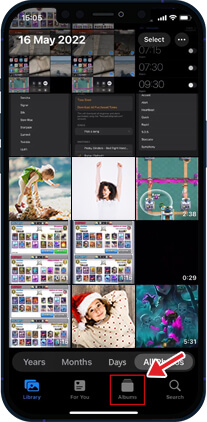
- Scroll down to find the Recently Deleted folder.

- Tap on the Select option at the top-right corner of the screen.

- Select the deleted photos you want to recover on your iPhone.
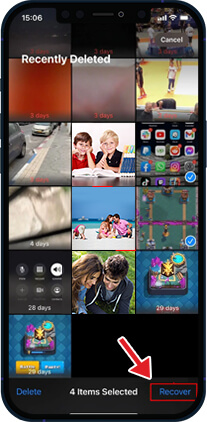
- Now, tap Recover, and the pictures will be returned to their original iPhone albums.
Note – If you want to restore all the deleted photos from your Recently Deleted folder, tap on the Recover All button.
How to Recover Deleted Pictures on iPhone From a Backup?
If your photos are not in the Recently Deleted folder, you might get them back by restoring your iPhone from a previous backup. There are three ways to restore deleted photos on iPhone – iCloud website, iTunes backup, or Finder.
When recovering photos from your iPhone from backup, pay attention to the date of creation of your backups. Use the most recent backup but don’t delete all older backups. It’s always good to have multiple backups if something goes wrong.
2. Recover Photos on iPhone using iCloud via the iCloud website
Apple’s iCloud Backup helps you recover deleted photos from your iPhone to your system. For iCloud to automatically back up all your pictures and videos, you must first set up and enable iCloud Photos on your device. Here’s how to enable iCloud Photos to Backup all your photos:
- Open the Settings app on your iPhone.
- Tap iCloud and then go to Photos.
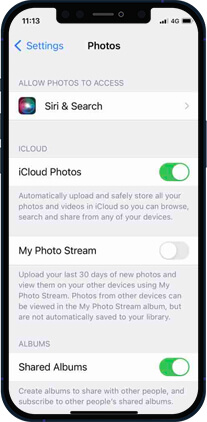
- Toggle on iCloud Photos to enable it.
To restore photos from iCloud, follow these steps:
- Go to the iCloud Website and log in with your Apple credentials.
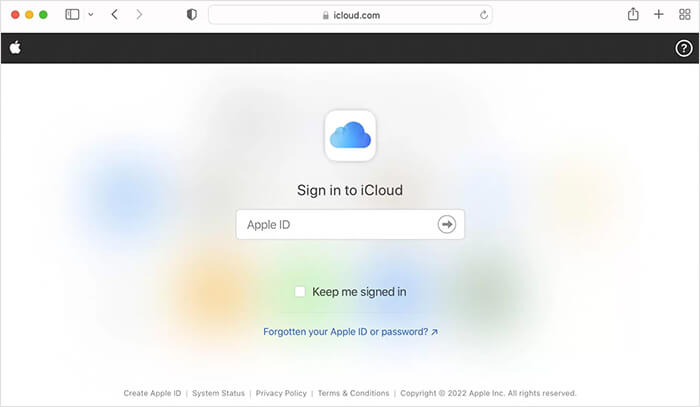
- Once logged in, select ‘Photos’ from the app list.

- Go to Recently Deleted Album, select the photos you wish to restore, and click Recover.
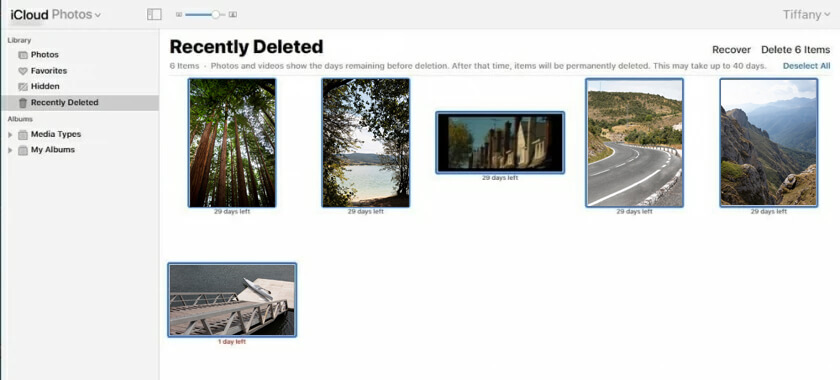
3. Recover Photos on iPhone using iTunes
Many iPhone users use iTunes backup to recover their deleted photos and videos. This Apple’s proprietary tool syncs your iPhone files to your PC or Mac. Follow the steps to recover deleted photos from iTunes backup:
- Connect your iPhone to your Mac system with macOS Mojave or an earlier version.
- Click on the iPhone icon at the upper-left corner of your iTunes window.
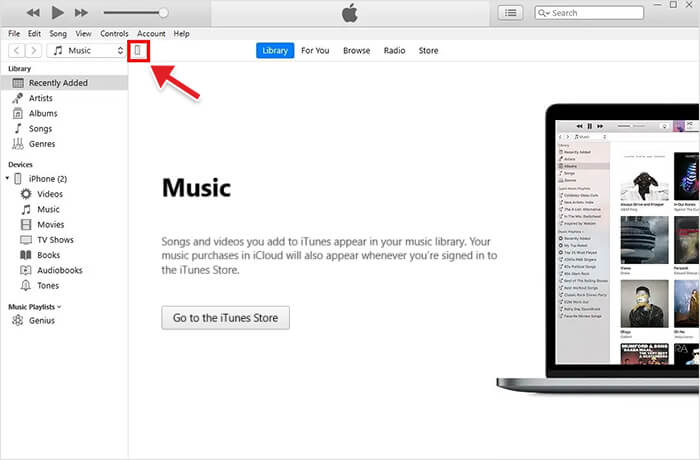
- Click the Summary tab in the left pane.
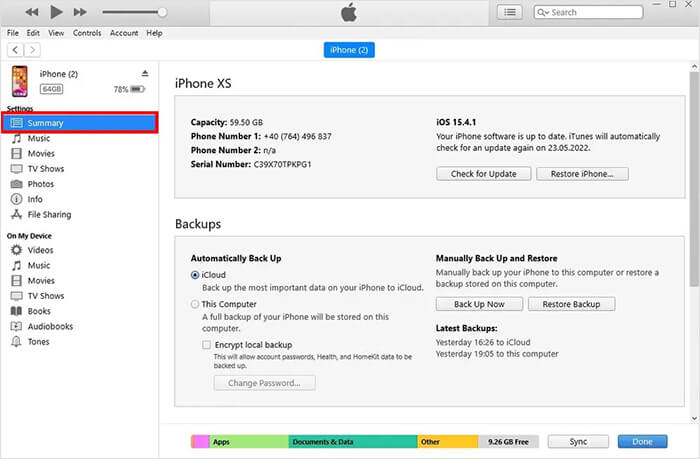
- Now in the Backups section, click on Restore Backup.

- Select the backup you want your phone to use.
Note - macOS Mojave is the last version of Apple’s OS to ship with iTunes. In macOS Catalina and newer version, iTunes is split into different apps: Podcasts, Books, TV, and Music. Moreover, Finder is used to manage and sync content on your iPhone, iPad, and iPod touch.
- Once the restoration process is complete, check the Photos app to see if the deleted photos were recovered. If not, try repeating the process and return to the most recent backup or choose an older backup.
4. Recover Deleted Pictures on iPhone using Finder
To restore the pictures on iPhone using Finder in macOS Catalina 10.15 or above, follow these steps:
- Open Finder on your Mac with macOS Catalina 10.15 or above.
- Connect your iPhone to your Mac system.
- Select your iPhone from the location lists on the left.

- Navigate to the General tab and click Restore Backup.

- Select the backup date you like to use for restoring.

- Click the Restore button to confirm.
How to Recover Pictures on iPhone without Backup?
What to do if there is no iPhone backup or you cannot restore pictures using iCloud or iTunes? Use iPhone data recovery software to restore lost iPhone pictures.
Stellar Data Recovery for iPhone can find and restore deleted/lost pictures, videos, chat messages, audio, contacts, etc., from your iPhone/iPad/iPod touch. This software is easy to use when restoring deleted photos, and you can operate it even if you don’t have technical knowledge. Follow the steps to discover how to use software to recover deleted photos:
- Connect your iPhone to your computer.
- Download Stellar Data Recovery for iPhone on your PC or Mac.
- Select Recover from iPhone on the main screen of the software.
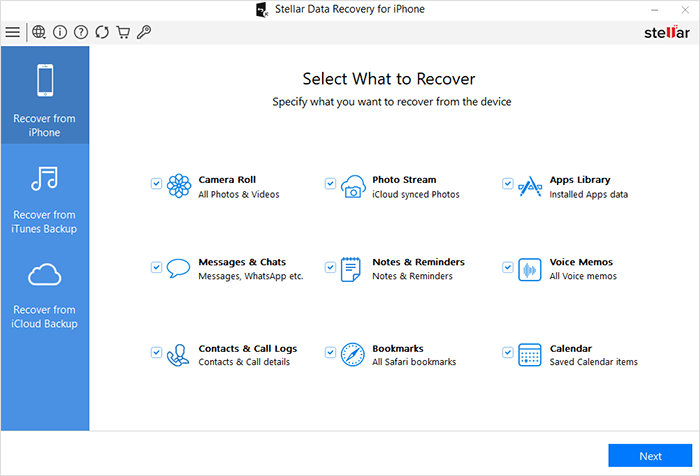
- Select the data type and click Next. The scanning process will start.
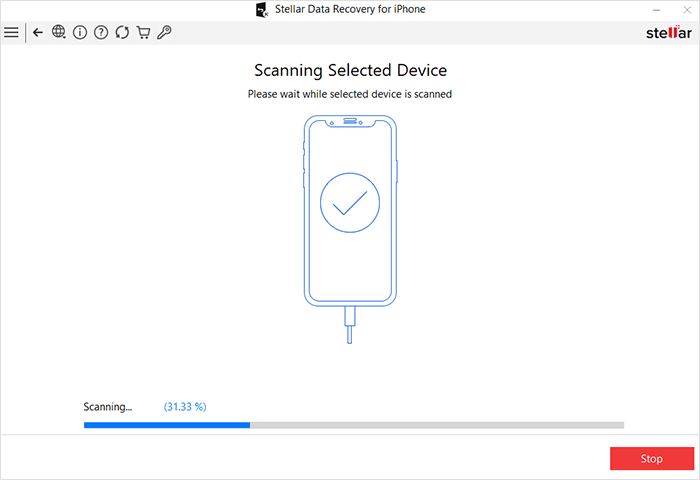
- Once the scanning is completed, preview the data. Select the recovered data you want to restore and click Save.

- Choose the destination to save the recovered data.

Conclusion
The data loss issues in Apple can be resolved easily through multiple backup solutions — iTunes, iCloud, and iCloud.com. However, these native backup recovery solutions fall short when you need to recover specific data, though you can easily recover deleted photos in your iPhone from these backup options. However, you will also end up replacing every existing data on your device!
Stellar Data Recovery for iPhone fills this gap quite efficiently. It recovers your deleted photos in water damage, jailbreak, factory reset, Black Screen of Death, etc. In addition, this software has an exceptionally high data recovery success rate, making it an essential utility for iPhone users.
6 Things We Can Do To Save A Water Damaged iPhone
“Hey there! I accidentally spilled water on my iPhone 14 Pro yesterday and it won`t turn on anymore. I was pretty sure I retrieved the phone within 10 seconds, yet it’s not working! Is there a way to save and fix water-damaged iPhone?”
If you’ve ever accidentally dropped your phone in water or drenched it in rain, then you’re not alone. From a split cup of coffee or water to dropping it in pools, bathtubs or toilets, your iPhone can be water-damaged due to various reasons.
With new-generation Apple devices, water exposure isn’t an immediate death sentence for your iPhone as it used to be. But it can still create issues in your iPhone, such as:
- Liquid droplets flowing inside the iPhone screen
- Issues in the charging port or the iPhone won’t charge.
- No audio or ruffled audio.
- Blurry images due to moisture in the camera lens.
- The internal part of the device gets corroded.
While the new iPhones have good water resistant capabilities, this doesn’t mean they are totally immune to water. Being electronic devices, water can seriously damage them.
This article shares several best practices that can help you save a water-damaged iPhone. But first, let’s understand how water resistant your iPhone is.
Is my iPhone water resistant?
The water resistance of the smartphones is rated by the “ingress protection” code, also called IP rating.
This rating includes two number: the first number indicates protection against solids, such as dust, whereas the second demonstrate resistance to liquid, mainly water. For example, the iPhone 12 has a rating of IP68, which means it provides six levels of protection from solid and eight levels of protection from liquid.
There are multiple types of IP ratings, but IP67 and IP68 are mainly applied to iPhones.
- IP67 – A device with this rating can withstand being submerged in up to 1 meter of water for a maximum of 30 minutes
- IP68 – iPhone with an IP68 rating can survive submersion in water up to 2 meters for a maximum of 30 minutes
Here’s the list of last few generation iPhone with their IP rating
- iPhone 15/15 Plus/ 15 Pro/ 15 Pro Max – IP68
- iPhone 14/14 Plus/ 14 Pro/ 14 Pro Max – IP68
- iPhone13/ 13 Mini/ 13 Pro / 13 Pro Max – IP68
- iPhone12/ 12 Mini/ 12 Pro / 12 Pro Max – IP68
- iPhone 11/ 11 Pro / 11 Pro Max – IP68
- iPhone XS/ XS Max – IP68
- iPhone X/XR /8/8 Plus /7 /7 Plus/ SE (2nd generation) – IP67
What Not to Do?
Most iPhones offer certain level of water resistance, but it doesn’t mean an iPhone dropped in swimming pool or a bucket full of water is immune to any damage. Moreover, not every repair step will help you fix water-damaged iPhone; and some can complicate things further. Before, we start on potential steps to save your water-damaged iPhone, let’s first look at some absolute things that worsen the cause and should be avoided at all costs.
### **1\. Don’t turn on your iPhone**Your iPhone will turn off automatically after being dropped in water. However, you should manually turn it off if it doesn’t turn off. Turn your phone on only if you are sure water or moisture content from the exterior and interior is completely dry. Turning on the water-damaged iPhone might cause water to reach inside the device, causing it to malfunction.
2. Plug it in or Use the Charging Port in Any Way
Moreover, don’t charge your iPhone battery as it can result in an electrical short circuit or even combustion, resulting in a fire. No matter how water resistant the iPhone is, it’s better to not plug it in when wet or water-damaged.
3. Don’t use hot air to blow dry your iPhone
Blow-drying your iPhone with hot air can damage your device further. Hot air may heat your iPhone to an unbearable degree, making it unsuitable for device hardware. Also, avoid using a space heater or furnace sidewall exhaust to dry your iPhone.
Steps You Can Take to Potentially Save Your Water-Damaged iPhone
If you drop your iPhone in water, the following methods can save your iPhone from potential damage.
1. Take it out and turn it off immediately
Remove your iPhone from the water right away. Once retrieved, turn it off immediately. If there is any iPhone cover and screen guard to protect your phone, remove them as they might hold moisture. Use a paper towel or cotton cloth to wipe the iPhone’s exterior.
2. Evacuate the SIM card
After drying the iPhone’s exterior, remove the SIM card tray, if not using an e-SIM. Although SIM cards have a watertight seal, getting them out helps. Use a paper towel to dry the SIM card and the tray.
3. Dry your iPhone
While Apple recommends simply wiping the iPhone dry or tapping excess water out of the ports, we recommend the below-mentioned ways to ensure your iPhone is as dry as possible.
- Place it in a dry place
You need to place the iPhone in a warm and dry place so the water inside the phone can evaporate. Place it in a nearby window with proper sunlight, but do not expose the device to harsh sunlight.
- Place it in uncooked rice
The uncooked rice trick used to be the go-to method to dry any visible liquid in iPhone, as rice absorbs moisture quickly. Place the iPhone in a bag or bowl of rice for a day or two to ensure the water traces inside the phone are absorbed entirely. However, this method is slightly risky, as uncooked rice can push grains and dust in the charging port of your device.
- Dry it with silica gel packets
If the water has seeped into the internal parts of the iPhone, try burying it in a heap of silica gel bags in an airtight container. This helps in absorbing the moisture from the inside of your iPhone. Using silica gel packets is a safer alternative to the uncooked rice method for drying a wet iPhone, as nothing will get clogged in the ports.
- Use a hairdryer (if it has a cool wind setting)
If your hair dryer has a cool wind setting, you can use it to dry wet iPhone. While drying the iPhone, keep the hair dryer in low mode and keep your iPhone at a distance so that air blowing doesn’t cause any damage.
Or, you can keep your iPhone under a cool air fan to dry it.
4. Disassemble the phone and let it air dry
If drying the iPhone via uncooked rice method or silica gel packet doesn’t work, consider dismantling it as your last resort. You can use DIY repair tips to open the device to dry it out or go to any trusted tech expert.
Caution: We wouldn’t recommend dismantling the iPhone using DIY tips as it may worsen the problem.
Dismantle your iPhone carefully, air dry its interior, and assemble it back after a few hours. Also, if the Liquid Contact Indicators inside the iPhone have already detected water damage, opening the phone invalidates your warranty coverage.
5. Check if your warranty is still valid
If all the above efforts fail to fix the iPhone from water damage, you must check if the device’s warranty is still valid. If it is, call your manufacturer and request a repair or replacement. If it is invalid, visit an Apple Genius bar to repair your cell phone.
6. Take the phone to an approved repair shop
The longer you wait to take your iPhone to an Apple Genius bar, the more damage it incurs. If you cannot dry the wet iPhone by following the manual methods mentioned above, rush to an Apple Genius bar to get it repaired and minimize the chances of further damage.
How To Find Out If Your iPhone Has Water Damage?
Liquid Contact Indicator, or LCI, is the new way to determine whether or not your iPhone is exposed to water damage. An LCI is generally of white or silver color; however, when it comes in contact with water or other liquid, it turns red.
See the table to learn where the indicators are planted in your respective iPhone, depending upon its model.

How To Recover Data From Water-Damaged iPhone?
Once you have powered on your water-damaged iPhone after drying, it is possible to recover data from it. There are two ways to recover lost data from water-damaged iPhones: backup services or professional iPhone data recovery software .
Let’s see various scenarios where you can recover data from a water-damaged iPhone:
iPhone won’t turn on
If your iPhone won’t turn on even after drying the wet iPhone using the tips mentioned above, it has short-circuited or water has eroded some of its internal components. In such a situation, use any backup service to recover your iPhone data.
If you have enabled iCloud backup on your iPhone, you can easily restore your data. You can visit the official iCloud website and log into your account to save the lost data on your computer. Or, set up your new iPhone using the existing iCloud credentials to restore the data of your previous iPhone.
iPhone starts but data is lost
If you turn your iPhone back on again, but its data is lost, try setting up your phone with existing iCloud account to recover the data. However, if you haven’t enabled iCloud backup, it is recommended that you use reliable iPhone data recovery software like Stellar Data Recovery for iPhone. This software recovers deleted/lost photos, videos, audio, messages, voice memos, calendars etc. from iPhone, iPad, iTunes, and iCloud backup files.
The software supports recovery in all data loss scenarios like water-damaged devices, accidental deletion, failed iOS updates, iPhone stuck in recovery mode, etc. This iPhone recovery software is compatible with all variants of iPad and iPhone, including the series of iPhone 15/14/13/12/11 and below.
Conclusion
We hope you fix the water-damaged iPhone after following the above suggestion. However, it would be best if you were extra careful to protect your iPhone from any type of water damage. Here are some best practices you must follow:
- Use a waterproof case to provide an additional layer of protection to your iPhone against water.
- Keep your iPhone away from sinks, bathrooms, toilets, etc.
- Be mindful in rainy conditions, and put your phone in a waterproof bag or safe pocket.
- Refrain from touching your iPhone with wet hands.
- Take regular data backups, as it is handy in data loss situations.
Was this article helpful?
FAQs
What do I do if my iPhone speaker doesn’t work after falling into water?
If there is water in your iPhone speaker, it may not work. In such a situation, try drying your iPhone and turning it on to take a backup of your data before testing the speaker. You can even visit Apple Genius Bar to get the help of a tech expert to fix your iPhone.
How to Recover Data from Broken iPhone Screen
Summary: Struggling to recover data after your iPhone’s screen broke? Stellar Data Recovery for iPhone can help restore data efficiently from an iPhone with a broken screen.
Your iPhone is the most cherished personal gadget as it has become more innovative and influential due to its many valuable features. Moreover, information such as notes, contacts, iMessage, calendar entries, text messages, WhatsApp/Kik messages, pictures, and videos are readily available, making it even more lovable. This is why we need to know how to recover data from broken iPhone screens.
These days, though there are plenty of best ways to back up your data, users often overlook the importance of Backup. It happened with _Jacky Jainco; w_hile taking a DSLR-like photo on his iPhone 14 Pro Max, he accidentally dropped his iPhone and, consequently, broke it.
The real problem was not the broken iPhone but to recover data from iPhone as it was not synced with iTunes and iCloud Backup. As a result, he couldn’t access his files, more importantly, his pictures.
You might have dropped your iPhone several times, and luckily, the excellent cover has saved it on all occasions. However, any drop could cause potential damage putting your data at stake; therefore, leverage iTunes or iCloud backup to recover data from the damaged iPhone screen.
Bringing Back Your Data From Backup
You can restore your files from either iTunes or iCloud Backup. In addition, replacement screens are available; you can have an appointment with the genius bar, get your damaged iPhone fixed, and then recover your data. Also, when backup files are inaccessible, turn to an iPhone data recovery software for an easy solution.
Sorting backup files is unmanageable as they tend to be large, running into GBs. Moreover, the process can be tedious, especially when you have to sort all files, even when you need to recover only a specific file. So it is when iPhone Data Recovery Software by Stellar is fruitful. The software lets you recover deleted files from encrypted iTunes backup files or recover data from an iPhone that would not turn on. Stellar Data Recovery for iPhone supports broken iPhone data recovery from series of iPhone 15, 14, 13, 12, 11, XR, XS, X, 8 Plus, 8, 7 Plus, 7, 6S Plus, 6S, 6 Plus, 6, 5S, 5C, 5, 4S, and 4.
You can recover a specific file without the pain of going through all backup files as the software lists all the files in an organized structure, thus, saving your precious time and effort.
Watch how to recover photos from a broken iPhone:
Recover your data from iTunes Backup
Here’s how to recover your iTunes backup using Stellar Data Recovery for iPhone.
1. Select the ‘Recover from iTunes Backup’ option.

2. List of your iTunes backup files appears. Select the relevant iTunes backup

3. In the middle pane, select the files you wish to recover and click the ‘Save’ button.

Recover your data from iCloud Backup
Another effective way to recover data from broken iPhones is through iCloud Backup. For any reason, let’s suppose you cannot access your iCloud backup files; then, using the ‘Recover from iCloud Backup’ feature, you can restore all your essential files. The simple steps are as follows:
- Click ‘Recover from iCloud Backup.’
- Sign in to your iCloud account to view the list of available backup files.
- In the left pane, click on the supported file list categories to view files under them.
- Select the files that you wish to restore and click ‘Save.’
Stellar Data Recovery for iPhone recovers the deleted photos, contacts, messages, etc., from the backup files and restores them to the device.
That’s Not All
Apart from recovering data from damaged iPhones, Stellar Data Recovery for iPhone facilitates the option to import the recovered files to your new or fixed iPhone.
To import your recovered files, follow these steps:
- First, connect your iPhone to the system, run the software, and click the ‘Import file to iPhone’ option.
- Click ‘Browse’ and select the files you wish to import to your iPhone.
- Click ‘OK’ to preview the selected files.
- Click ‘Transfer to iPhone’ to transfer recovered files to your iPhone.
To Sum Up
When your iPhone is damaged, try the basics, i.e., restart it; if that works, back up as much data as possible. You can also restore your files from iTunes or iCloud Backup if there are any. Else, make an appointment with the genius bar and get your iPhone fixed. They might also help you recover data from the damaged iPhone, which comes with an asterisk. Therefore, turn to Stellar Data Recovery and save time and energy for efficient recovery of your data.
## How to Delete All Photos from iPhone Beyond Scope of Recovery?Summary: Learn how to delete all photos from your iPhone beyond the scope of recovery with this comprehensive guide. We’ve also mentioned an iPhone eraser software that securely erases your photos for good and safeguards your privacy.
Are you planning to sell or discard your iPhone? If yes, it’s important to ensure that your personal data, such as photos and videos, etc. is deleted and cannot be recovered even by a professional data recovery tool. To protect your privacy and prevent unauthorized access to your deleted iPhone photos, make sure your iPhone is wiped clean of all your previous photos before you sell, donate, or discard it.
In this blog, we will talk about different ways to delete photos from iPhones beyond the scope of recovery.
## **How to Delete All Photos from iPhone?**Before deleting all photos from the iPhone, it’s important to take a backup of all photos to avoid any accidental data loss situation. There are various ways to back up your iPhone photos:
1. iCloud
Use iCloud to back up all your photos automatically. To sync iCloud with Photos –
- Go to Settings > [your name] > iCloud > Photos, and turn on iCloud Photos.

Your photos will be backed up to iCloud automatically if your device has enough storage space and is connected to Wi-Fi.
2. iTunes:
You can even use iTunes to back up your iPhone photos. To do this,
- Connect your iPhone to your system.
- Launch iTunes and then select your device.
- Click Summary > “Back Up Now” to create a backup of all your data, including photos.

Once you have backed up all your photos, proceed forward with deleting them from your iPhone.
Method 1: Delete Images From Photos and Recently Deleted Folder
Photos app saves images shot from iPhone as well as those received on chats. You can delete all the photos from your iPhone via the Photos app. Here’s how to do it.
- Open the Photos app on your iPhone.
- Go to the Library tab, tap All Photos, and then tap Select.
- Select one or multiple photos you want to delete.
- Tap on the Trash icon and then confirm to delete the photos.

When you delete a photo from the iPhone, it’s not deleted permanently. Instead, it is moved to the Recently Deleted folder, where the deleted photos stay for 30 days before being permanently deleted.
To permanently delete photos from the Recently Deleted folder, follow these steps:
- Open the Photos app > Albums.
- Scroll down, then tap on Recently Deleted.
- Next, tap Select and choose the photos that you want to delete permanently.
- Tap Delete and then confirm to delete the photos.

Remember, if iCloud sync is enabled, photos deleted from iPhone will be deleted on iCloud. That is why if you want to delete photos from your iPhone but not on iCloud, make sure iCloud sync is disabled for Photos.
Method 2: Factory Reset Your iPhone
Apple’s brilliant feature of the ‘Erase All Content and Settings’ option brings your device to default settings by erasing all your iPhone data, etc.
The factory reset will delete all the settings, photos, audio, videos, messages, notes, call history, search history, app history, passcodes, and any other data on your iPhone.
However, remember erasing your iPhone data with the ‘Erase All Content and Settings’ doesn’t delete your data permanently. It means that all your iPhone data including photos are still recoverable with the help of robust iPhone data recovery software .
Steps to Factory Reset iPhone
- Open Settings on your iPhone.
- Go to General and tap on Transfer or Reset iPhone.
- Click on the Erase All Content and Settings options.
- Click Continue and enter your iPhone passcode.
- Next, click Erase iPhone. This will fully wipe your device clean.

Note: Don’t forget to back up your iPhone data on iCloud or iTunes before initiating the factory reset. Because this backed-up data can be accessed on your computer or new iPhone.
Stellar Eraser for iPhone is the best way to delete permanently erase all photos as well as other data of the iPhone. The software erases all your photos, contacts, videos, chats, iMessage, browser search history, third-party apps data, and more from your iPhone.
The Stellar iPhone Eraser tool is the best way to clean or delete iPhone data. This tool deletes iPhone data permanently making it impossible to recover it from any software. It is the best data erasure tool for iOS devices before you exchange, sell, recycle, or give them away.
The software works with all iPhones and iPad versions, such as iPhone 14 to lower versions till iPhone 4 and supports iOS versions from iOS 6.0 to iOS 16.
Steps- How to Delete All Photos From iPhone via Stellar Eraser for iPhone
- Download and install Stellar Eraser for iPhone on your Windows and Mac systems.
- Launch the software and click on the Erase Data option.

- In the next Erase iPhone Data screen, click Next.

- Connect your iPhone to the system when prompted and click Erase.

- Click Yes to start the process of erasure.

- Click OK, once all the data is successfully erased.

All the data including photos and videos get permanently erased from iPhone beyond the scope of recovery.
Conclusion
Deleting all photos from your iPhone beyond the scope of recovery is crucial to protect your privacy and prevent unauthorized access to your personal data. By following the methods above, you can ensure that all your photos are deleted permanently from your iPhone. However, the best way to delete all photos from iPhone is by using Stellar Eraser for iPhone. The software will help you erase photos and other data from your iPhone so that it is impossible to recover it using any data recovery software.
FAQ
1. How to Delete Photos from iCloud?
To delete Photos from iCloud, follow these steps:
- Open Settings > tap on your Apple ID > iCloud.
- Then tap Manage Storage and select Photos.
- Next tap Disable and Delete. It will disable your photos from being saved on your iCloud account.
2. How to delete apps on iPhone permanently?
If you want to delete apps on your iPhone for managing the storage space then you directly remove it from Home Screen or delete it from App Library.
3. How to delete documents and data on iPhone?
Documents and Data folder may contain browsing history, cookies, cache, temporary files, database files and other information specific to the app. You can delete them easily by following this detailed guide .
- Title: How to Recover deleted pictures on iPhone 13? 5 Best Solutions | Stellar
- Author: Nova
- Created at : 2024-08-20 20:03:05
- Updated at : 2024-08-21 20:03:05
- Link: https://blog-min.techidaily.com/how-to-recover-deleted-pictures-on-iphone-13-5-best-solutions-stellar-by-stellar-data-recovery-ios-iphone-data-recovery/
- License: This work is licensed under CC BY-NC-SA 4.0.







